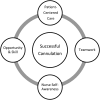Improving vascular access outcomes: attributes of arteriovenous fistula cannulation success
- PMID: 26985384
- PMCID: PMC4792629
- DOI: 10.1093/ckj/sfv158
Improving vascular access outcomes: attributes of arteriovenous fistula cannulation success
Abstract
Background: Arteriovenous fistulas (AVFs) are the preferred access for hemodialysis (HD) yet they are underutilized. Cannulation of the fistula is a procedure requiring significant skill development and refinement and if not done well can have negative consequences for patients. The nurses' approach, attitude and skill with cannulation impacts greatly on the patient experience. Complications from miscannulation or an inability to needle fistulas can result in the increased use of central venous catheters. Some nurses remain in a state of a 'perpetual novice' resulting in a viscous cycle of negative patient consequences (bruising, pain), further influencing patients' decisions not to pursue a fistula or abandon cannulation.
Method: This qualitative study used organizational development theory (appreciative inquiry) and research method to determine what attributes/activities contribute to successful cannulation. This can be applied to interventions to promote change and skill development in staff members who have not advanced their proficiency. Eighteen HD nurses who self-identified with performing successful cannulation participated in audio-recorded interviews. The recordings were transcribed verbatim. The data were analyzed using content analysis.
Results: Four common themes, including patient-centered care, teamwork, opportunity and skill and nurse self-awareness, represented successful fistula cannulation. Successful cannulation is more than a learned technique to correctly insert a needle, but rather represents contextual influences and interplay between the practice environment and personal attributes.
Conclusions: Practice changes based on these results may improve cannulation, decrease complications and result in better outcomes for patients. Efforts to nurture positive patient experiences around cannulation may influence patient decision-making regarding fistula use.
Keywords: AV fistula; appreciative inquiry; emotional intelligence; hemodialysis.
Figures
Similar articles
-
The culture of vascular access cannulation among nurses in a chronic hemodialysis unit.CANNT J. 2010 Jul-Sep;20(3):35-42. CANNT J. 2010. PMID: 21038828
-
Moving beyond the "perpetual novice": understanding the experiences of novice hemodialysis nurses and cannulation of the arteriovenous fistula.CANNT J. 2013 Jan-Mar;23(1):11-8. CANNT J. 2013. PMID: 23659029
-
How to needle: A mixed methods study on choice of cannulation technique for arteriovenous fistula.J Clin Nurs. 2023 Aug;32(15-16):4559-4573. doi: 10.1111/jocn.16454. Epub 2022 Jul 10. J Clin Nurs. 2023. PMID: 35811391
-
Cannulation practices at haemodialysis initiation via an arteriovenous fistula or arteriovenous graft.J Vasc Access. 2020 Sep;21(5):573-581. doi: 10.1177/1129729819869093. Epub 2019 Aug 18. J Vasc Access. 2020. PMID: 31423945
-
Arteriovenous fistula cannulation in hemodialysis: A vascular access clinical practice guidelines narrative review.J Vasc Access. 2022 Sep;23(5):825-831. doi: 10.1177/11297298211006972. Epub 2021 Apr 30. J Vasc Access. 2022. PMID: 33926285 Review.
Cited by
-
Variables associated with successful vascular access cannulation in hemodialysis patients: a prospective cohort study.BMC Nephrol. 2019 May 31;20(1):197. doi: 10.1186/s12882-019-1373-3. BMC Nephrol. 2019. PMID: 31151432 Free PMC article.
-
Patients' experiences of cannulation of arteriovenous access for haemodialysis: A qualitative systematic review.J Vasc Access. 2023 Sep;24(5):1121-1133. doi: 10.1177/11297298211067630. Epub 2022 Jan 16. J Vasc Access. 2023. PMID: 35034481 Free PMC article.
-
Imaging in Vascular Access.Cardiovasc Eng Technol. 2017 Sep;8(3):255-272. doi: 10.1007/s13239-017-0317-y. Epub 2017 Jul 13. Cardiovasc Eng Technol. 2017. PMID: 28707187 Free PMC article. Review.
-
UK Kidney Association Clinical Practice Guideline on vascular access for haemodialysis.BMC Nephrol. 2025 Aug 14;26(1):461. doi: 10.1186/s12882-025-04374-y. BMC Nephrol. 2025. PMID: 40813633 Free PMC article. Review.
-
Examining the Effect of Haptic Factors for Vascular Palpation Skill Assessment Using an Affordable Simulator.IEEE Open J Eng Med Biol. 2020;1:228-234. doi: 10.1109/ojemb.2020.3017156. Epub 2020 Aug 17. IEEE Open J Eng Med Biol. 2020. PMID: 33681817 Free PMC article.
References
-
- Mendelssohn D, Beaulieu M, Kiaii M, et al. Report of the Canadian Society of Nephrology Vascular Access Working Group. Semin Dial 2012; 25: 22–25 - PubMed
-
- Thomas A, Appleton D, Browning R, et al. Clinical educators network nursing recommendations for management of vascular access in hemodialysis patients. CANNT J 2006; 16(Suppl 1): 6–17
-
- National Kidney Foundation. KDOQI clinical practice guidelines and clinical practice recommendations for 2006 updates: hemodialysis adequacy, peritoneal dialysis adequacy and vascular access. Am J Kidney Dis 2006; 48(Suppl 1): S1–S332 - PubMed
-
- CIHI. CORR Annual Report: Treatment of End-Stage Organ Failure in Canada 2002–2012. Toronto: Canadian Institute for Health Information, 2013
LinkOut - more resources
Full Text Sources
Other Literature Sources



